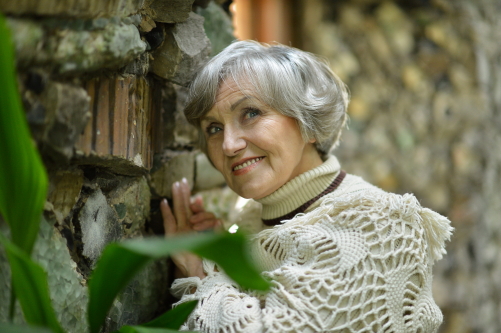AMD stands for age related macular degeneration. This is the most severe cause of irreversible vision loss in people over the age of 60 years. The disease occurs at a small area of the central portion of the retina, this area is known as the macula. The retina is the layer of the eye which senses the light and gives rise to the nerve that carries visual information to the brain. The development of the disease occurs as the person ages. This is not always a condition that can cause blinding, however this can lead to significant visual disability. Vision loss is the primary age related condition which limits an older adult’s ability to live alone, or live with only part-time assistance and care. The full time care available in an assisted living community is a natural fit for retired adults with age related macular degeneration.

There are two main types of age related macular degeneration.
The dry form of this condition is caused by yellowish colored deposits called drusen in the macula. Little amounts of drusen will not impair the vision but as the person ages the number of drusen increase and they grow in size and number. This can cause dimming or distortion of the vision. This is noted by most people when they start to read. As the condition advances this can lead to thinning of the macula and loss of the light sensitive tissue layers. This is a very severe form which can cause a blind spot in the center of their visual field.
In the wet form of AMD the disease is caused by growth of abnormal blood vessels, from the choroid layer which supply blood vessels to the retina, underneath the macula. These abnormal blood vessels leak blood and fluid which cause distortion of the images seen. The straight lines appear wavy and there will be blind spots in the central visual fields. These abnormal blood vessels can lead to bleeding and eventually will form scars. This can lead to permanent visual loss.
The most common form is the dry form of AMD. This can account to some degree of loss of central vision. Latest research suggests that in 10% of the cases dry form of AMD can lead to wet form, which is the more serious form of the disease. It is very important to monitor the eye sight regularly to check the progression of the disease. This condition can be hereditary, family history is a strong risk factor of acquiring this condition. Apart from family history, some other risk fact_ors are smoking, high blood pressure, and high cholesterol levels.
There are many signs and symptoms of the disease, however, few symptoms are evident at the early stages.
The first sign of macular degeneration is usually blurred vision with a dim, blurry spot in the middle of your vision. This spot may get bigger or darker over time. Other symptoms include dark, blurry areas in the center of vision diminished or changed color perception.
The most important factor to be considered with age associated visual impairment is that the signs and symptoms are not clearly evident.
The elderly may not know they are suffering from visual impairment. Recent studies have shown that a significant amount of older adults visiting the ER due to falling injuries suffer from visual impairment due to age related visual loss. By moving into an assisted living community, the elderly are able to get their eyes checked and the disease progression can be monitored. Assisted living community are equipped with special visual aids and walking aids to help guide visually impaired adults.
Vision loss is a difficult situation for families to deal with. Very few families will be able to provide full time assistance in home to a loved one with vision loss. If you’re considering full time care options in Ventura County like assisted living, please contact Ventura Townehouse for more information about our care options and amenities, or to schedule a tour.
